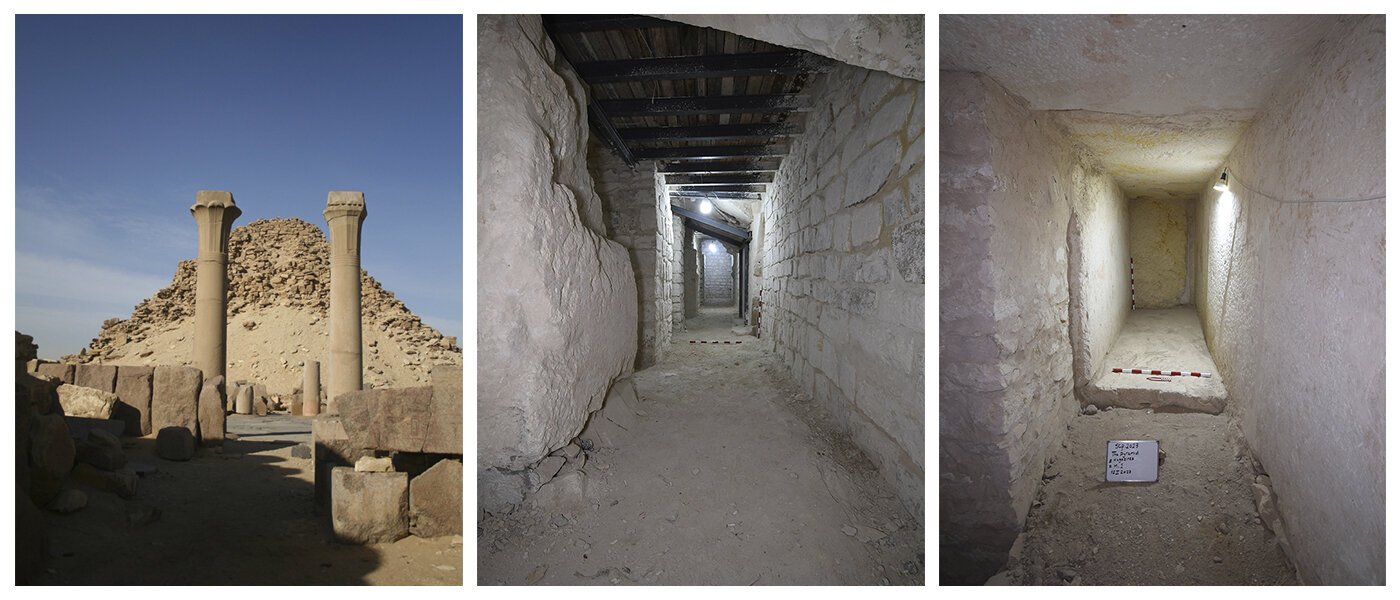An important find has been made inside Sahura's pyramid by an Egyptian-German mission led by Egyptologist Dr. Mohamed Ismail Khaled of the Department of Egyptology at Julius-Maximilians-Universität Würzburg (JMU).
From left to right: Exterior view of the pyramid. A passage secured with steel beams. One of the discovered storage rooms. Credit: Mohamed Khaled
A number of storage compartments that had never been discovered previously had been found throughout the exploration. The construction of the pyramid of Sahura, the second king of the Fifth Dynasty (2400 BC) and the first monarch to be interred at Abusir, has been illuminated by this discovery.
The Antiquities Endowment Fund (AEF) of the American Research Center in Egypt (ARCE) financed the conservation and repair project inside Sahura's pyramid, which was started in 2019 and was intended to protect the substructure. The team worked to stabilize the pyramid from the inside, clean the interior spaces, and stop future collapse. The team was able to secure the pyramid's previously inaccessible burial chambers in the process.
A Britisher with the right intuition
The team's discovery of the original measurements allowed them to reconstruct the antechamber's floor design, which had deteriorated over time. As a result, new retaining walls were built to replace the demolished ones. Only the northeast corner and about 30 centimeters of the eastern wall of the antechamber were still discernible due to severe damage to the wall's eastern side.
Excavations continued to uncover remnants of a low corridor that John Perring had already spotted in 1836. Perring had mentioned that the passage had been blocked off by decay and was clogged with trash and waste. The British Egyptologist thought it might have been a doorway to a room of storage. These presumptions were challenged, however, after Ludwig Borchardt's additional exploration of the pyramid in 1907, and other specialists agreed with him.
Even more unexpected was the discovery made by the German-Egyptian team, which really found remnants of a corridor. demonstrating the accuracy of the observations made during Perring's exploration. The passage was discovered when more work was done. So far, eight storerooms have been located. Remains of the original walls and portions of the old floor can still be visible, despite the fact that the northern and southern portions of these magazines, particularly the ceiling and the original floor, are severely damaged.
Using modern technology
The scholars' comprehension of the interior of the pyramid has significantly improved thanks to meticulous documenting of the floor layout and measurements of each storage space. In order to preserve the rooms' structural integrity while making them accessible for potential public use and future research, a balance between preservation and presentation was sought during the restoration process.
The Egyptian-German team worked with the 3D Geoscan team to undertake thorough surveys inside the pyramid using cutting-edge technology, including 3D laser scanning with a ZEB Horizon portable LiDAR scanner from GeoSLAM. With the use of cutting-edge technology, both the vast exterior spaces and the interior's cramped passageways and rooms could be thoroughly mapped. The regular scans produce a permanent record of exploratory efforts and offer real-time information on development.
The Sahura pyramid and its historical significance have been better understood thanks to this ground-breaking project. The finding and preservation of the storerooms is anticipated to challenge established assumptions in the area and completely alter how we think about the historical development of pyramid buildings.







